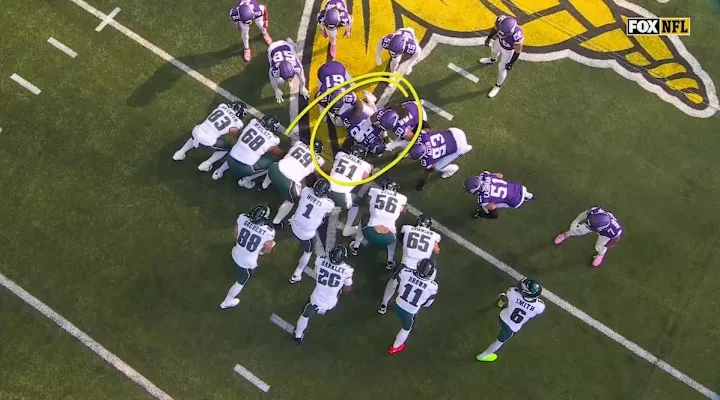The Philadelphia Eagles’ signature “tush‑push” play—where quarterback Jalen Hurts takes the snap and two teammates push him from behind as the offensive line surges ahead—has become one of the most efficient short‑yardage tactics in the NFL. It’s so successful that other teams now build weeks of game‑planning around the challenge of stopping it. One of those teams, the Minnesota Vikings, recently rolled out a novel defensive strategy in their effort to blunt the play—an approach that highlights how much teams are forced to think outside conventional frameworks to stand a chance.
To understand why Minnesota felt compelled to go to such lengths, consider the nature of the tussle. The Eagles have routinely placed themselves in short‑yardage situations—third‑and‑one, fourth‑and‑one—and executed the tush‑push with elite efficiency. Analysts note that since 2022 the Eagles have converted more than 90 % of such attempts, vastly higher than the league average for standard quarterback sneaks. Because the yardage required is minimal, the margin for error from the defense is tiny: if the offense wins its leverage battle up front, gains control of the center‑line gap, and executes well, the defense has little room to maneuver.
For the Vikings, known already for being one of the best teams at stopping short‑yardage conversions (they gave up fewer third/fourth‑and‑one conversions than almost anyone in 2024) facing the Eagles required innovation. Simply lining up standard defenders and hoping for a tackle at the line wasn’t enough when one small shove can reset the chains. So in their October 19, 2025 game, the Vikings’ defensive coordinator Brian Flores built a specific look for the tush‑push: they placed rookie linebacker Tyler Batty lying horizontally on the ground, directly in front of the Eagles’ center (Cam Jurgens) as the snap occurred, intending to clog the gap and disrupt the push‑motion behind Hurts. (SI)
The logic behind the maneuver: normally, the offense executes like this—center snaps the ball, the offensive line surges forward, the quarterback begins his forward surge, and immediately behind him two powerful pushers (often tight ends or fullbacks) come in, adding thrust. The key point the Vikings sought to defend is the A‑gap/center gap—the immediate space in front of the center where the offense gets the initial material‑momentum. If the defense can plug that, deny the surge, or at least collapse the gap rapidly, they might stop the play. What Minnesota did was attempt to physically occupy the gap before the snap with a defender lying flat and then bring other linemen collapsing in—a kind of “log‑jam” at the line. Jason Kelce, the former Eagles center closely associated with the tussle, called the play “interesting” and noted that the idea of using a horizontal body to plug the center gap was clever. (SI)
In execution, though, the result was mixed. On the first attempt of the game in that formation, the Eagles converted the fourth‑and‑1 with a standard tush‑push and got the first down. On the second time the formation appeared, the offense was flagged for a false start and forced to punt instead. So while Minnesota did not “solve” the tush‑push, they did generate a momentary disruption—uncharacteristic for the Eagles in that situation. (OutKick)
Why did the Vikings feel the need for such an unconventional alignment? Because the standard options are all compromised. If you overload the box with big bodies, you might leave uncontested run‑lanes or fall victim to motion‑misdirection. If you play fewer defenders at the line and more space defenders, the Eagles’ offensive line can simply surge ahead and overpower. The tush‑push also has the advantage of being built for that one‑yard breech: the offense knows it’s coming, the defense knows it’s coming, and yet the execution and structure of the play gives the offense the upper hand. A normal defensive line getting off the snap and engaging down‑blocks may not have enough time or leverage against that mass push.
Therefore, what the Vikings attempted was effectively to pre‑occupy the central surge point by placing a defender in static form ahead of the ball, intentionally giving up no movement, and then let the pushers behind the quarterback collide into the pocket of bodies pre‑positioned. It’s a strategy based on disruption of the initial flow, rather than expecting a typical read‑and‑react. By laying horizontally, the defender reduces vertical surge space, acts as a wedge or chock, and forces the offense to either accept less space or shift the play to the flanks.
There are a number of tactical nuances to examine here. First, rhythm: the defense loses conventional jump‑through‑blocks for surge, and must be ready for the snap with an unusual body orientation, which has risks (e.g., false starts, misalignment, communication breakdowns). Second, leverage: rather than standing up the center gap, the defenders must be lower, yet not so low that they impede their own visibility or ability to disengage to make a tackle. Third, gap integrity: when you clutter the A‑gap, the offense might simply shift the push outside to the B‑gap or C‑gap, so the defense must remain disciplined. Fourth, substitution/package implications: using a special alignment might signal to the offense what you’re doing, allow the offense to call a different play, or cause the defense to be unbalanced elsewhere.
For Minnesota, introducing such a look also sends a message: they will not shy away from maximal effort stops, they will prepare specifically for the tush‑push, and they will be willing to deviate significantly from standard fronts. That in itself can have value beyond the single play—it forces the opponent to consider alternate play‑calls or to hesitate in their normal cadence. That hesitation or change can lead to negative plays, penalties, or mis‑execution.
But of course, this strategy also underscores how difficult the problem is. Despite their long preparation, the Vikings still allowed a conversion on the first attempt. That reflects how elite the Eagles are in executing the play and how little margin there is for failure for the defense. One league commentator described the play as almost “physically impossible to stop” when the offense executes perfectly. (SI) Given that, any defensive tactic will likely be incremental improvement rather than an outright stop—forcing the play to be “less efficient” rather than “zero yards.”
Another layer to consider is the rules and broader context. The NFL debated banning the tush‑push after teams complained about its one‑dimensional nature and perceived unfairness (essentially multiple blockers pushing a runner, reminiscent of a rugby maul). A rule proposal to ban pushing or pulling the runner was brought forward (led by the Green Bay Packers), but it was voted down by the owners in May 2025. (NFL.com) That leaves the responsibility for stopping the play to each team’s defensive staff, which increases burden on coordinators like Flores to come up with bespoke solutions.
So, what can be drawn from Minnesota’s attempt? First, innovation is required. When you face an offense with a nearly automatic conversion tool, standard defenses may simply become reactive and too slow. A tactic that disrupts before the snap or plugs the crucial surge gap gives you at least a chance. Second, you must be willing to accept trade‑offs. Minnesota’s formation may compromise other parts of the field or invite mis‑execution because it deviates from base fronts, but sometimes the deviation is worth it given the cost of giving up the one yard. Third, you must have elite discipline. If the offense sees a defender lying horizontally at the line, it may adjust quickly, shift the play or motion the quarterback away. So the rest of the defense must remain disciplined and contain the edges or interior leak opportunities. Fourth, you must manage risk of penalties. In Minnesota’s case they forced a false start on the second attempt, which is actually a win in its own right—but had communication or alignment been wrong, they might have given up a free first down. Executing a radical front heightens risk of misalignment or illegal formation.
Finally, read this as broader advice for defenses in short‑yardage fights. The ordinary reaction (“get off the ball, the A‑gap defender shoot, the DE sets the edge, linebacker meets”) may not suffice when the offense has trained their surge‑mechanics with precision and uses mass momentum. You must break the rhythm. Minnesota’s horizontal defender was a clever attempt to disrupt the rhythm and shape the outcome. Other teams may follow, iterate, or adapt. Perhaps future opponents will bring in heavier personnel, unbalanced lines, or even different pre‑snap motion to neutralize the push.
In conclusion, the Vikings’ new strategy to defend the tush‑push—placing a defender lying across the line of scrimmage to clog the surge, then collapsing other defenders inward—demonstrates how much teams are having to adapt. While the tactic did not fully stop the Eagles on that occasion, it produced a result (false start) that traditional defenses seldom achieve. If the Eagles’ short‑yardage signature remains legal and potent, defenses will continue experimenting with unconventional alignments, “anti‑surge” front design, and gap‑block‑leverage disruption schemes. The Minnesota attempt may not be perfect, but it’s a sign that the arms‑race around the tush‑push is underway—and one defense willing to challenge the status quo may gain marginal advantages that turn important downs over the course of a season



